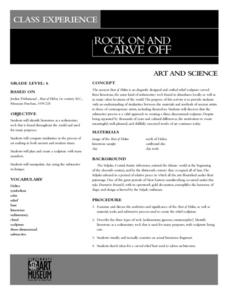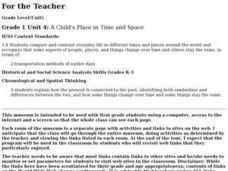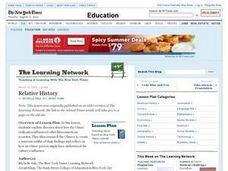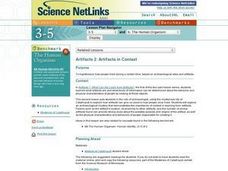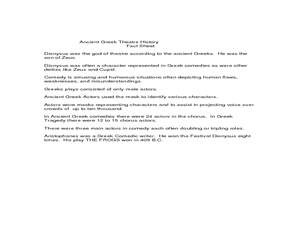Curated OER
Rock On And Carve Off
Sixth graders work in groups of four to create one subtractive relief bust out of clay. Team results are shared and discussed to analyze the degree of planning and skillful manipulation of materials necessary to complete a limestone bust.
Curated OER
Hunt the Fact Monster
In this Fact Monster search engine instructional activity, learners access the Internet to one specific website to find the answers to five questions with multiple choice answers.
Curated OER
Green Transportation System
Consider the effects of green transportation. In this environmental stewardship lesson, determine how transportation has changed throughout history and then collaborate to solve New York City transportation issues.
Field Museum
The Case of Darwin's Finches
One of the most striking pieces of evidence for Darwin's Evolution of Species was his observations of finches and how their beaks differed from island to island, depending on their primary food sources. So what would happen to the theory...
Curated OER
The Effect of Natural Selection on Genes, Traits and Individuals
Rotating through five stations, evolutionary biologists explore the question of how changes in DNA facilitate the changes in a population over time. High-quality, colorful cards of animals, skeletons, skulls, and DNA sequences can all be...
Curated OER
Auburn Cord Dusenberg Field Trip
Fifth graders compare two different vehicles and determine why the cars are designed differently. They write four facts learned from the field trip in their science journals including a fact about how force affects the performance of the...
Curated OER
I Can Sing a Rainbow....
In this Blakesley Hall Museum gardens worksheet, students view eleven pictures of garden flowers and learn the words to a garden song.
Curated OER
How Things Fly
Students observe photographs of selected twentieth-century aircraft at the National Air and Space Museum and note differences in the design of aircraft wings, fuselages, and engines.
Curated OER
Geography: I Spy Environments
Fourth graders examine nature paintings from a Utah museum for their physical characteristics. In small groups, they observe museum postcards and discuss the season, precipitation, temperature, and geometric shapes pictured. Focusing...
Curated OER
Sound
Second graders answer the question "What is a sound system?" They investigate sound systems and explain how sound is produced. Students visit the sound museum and at each station they predict how sound is made. They construct a simple...
Curated OER
Flight Home Lesson Plan 3
Students examine photographs of twentieth-century aircraft from the National Air and Space Museum. They compare aircraft wings, fuselages, and engines to investigate different approaches to aircraft design.
Curated OER
Using Lego Dacta to Control a Model of the Millennium Wheel
Students research things that are controlled by computer in their home, school and local area. They design and make toys with moving mechanisms as part of their design technology topic work. Students visit a toy museum or exhibition to...
Curated OER
What's In A Name?
Young scholars create a binomial system of nomenclature for classifying organisms they encounter in a field trip to a natural history museum or from pictures in library books. They work in small groups to create accurate drawings and...
Curated OER
From Brainstorm to Published Paper
Students investigate a topic through research, observation, and experimentation. They prepare a short science report and publish it online. Students reflect on the role of science reports in the larger scientific community.
Curated OER
University of California Botanical Garden Field Trip
Students explore plant species and the climates and conditions in their environment. They explore this living museum on the Garden's thirty-four acres to encounter over 13,000 plant species from around the globe.
Curated OER
Geology of Connecticut
Students examine the geology of Connecticut, including plate tectonics, glaciation, and fossil formation.
After reviewing past lessons, they write essays about what life may have been like in the Mesozoic Period. Following a field...
Curated OER
A Child's Place in Time and Space
First graders visit each room of an online virtual museum in order to study transportation in the United States through time.
Curated OER
Relative History
Students explore theories about how the Olmec civilization influenced other Mesoamerican societies. They research the Olmecs to create a museum exhibit of their findings and reflect on how an Olmec person might have understood the...
Curated OER
Artifacts 2: Artifacts in Context
Students explore world history by completing artifact worksheets. In this archaeology instructional activity, students identify the importance of finding clues when researching historical information by utilizing artifacts. Students...
Curated OER
Dancing with Dionysus
Sixth graders research Ancient Greek culture by acting in a play for the festival of Dionysus. In this Greek culture lesson, 6th graders study an ancient Greek map and the Sarcophagus Dionysus from the Walters Art Museum website....
Curated OER
Weather Watchers - Interdisciplinary
Students investigate weather and climate through a variety of interdisciplinary activities.
Curated OER
The Founder of Electromagnetism
Students identify and study the founder of electromagnetism. In this magnetism lesson students complete several experiments including building a galvanometer.
Curated OER
Bubble Trouble
Students participate in a bubble blowing contest. For this chemistry lesson, students work in teams to make the best bubbles. Students adjust the bubble solution to improve their bubbles.
Curated OER
Ear Gongs
Students create ear gongs and experiment with the sounds they make. In this ear gongs activity, students understand the path of sound. Students experiment with a coat hanger to cause vibrations.


